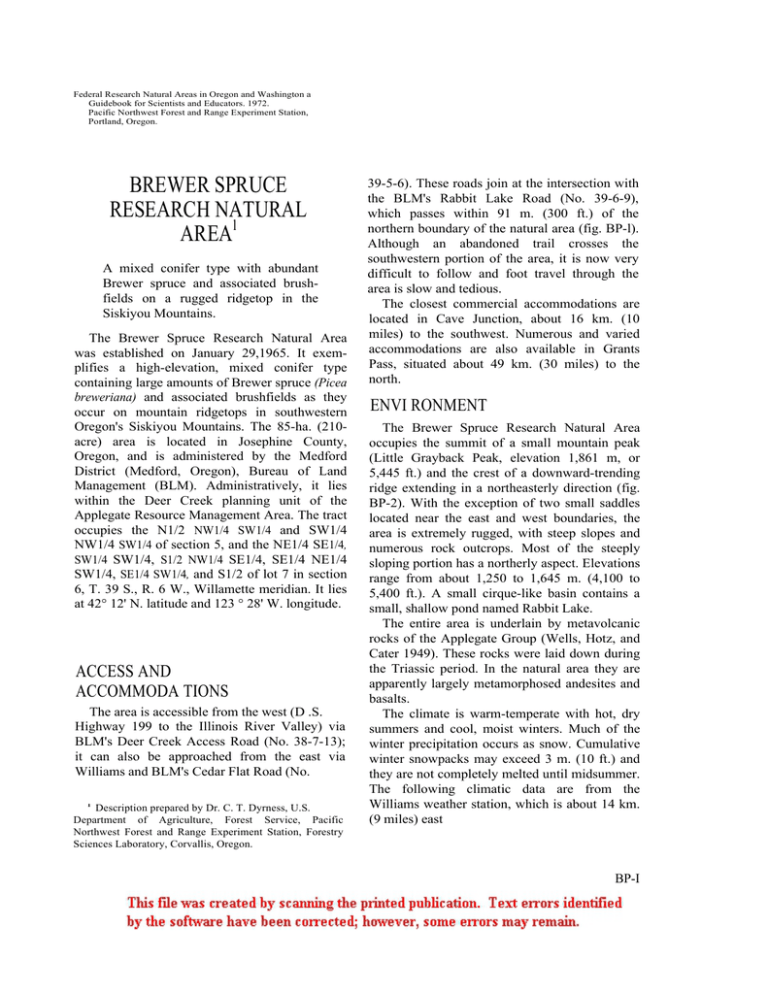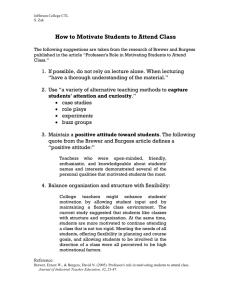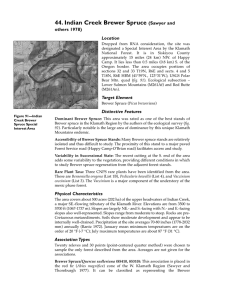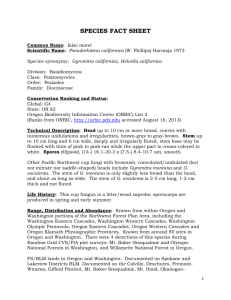Document 11341133
advertisement

Federal Research Natural Areas in Oregon and Washington a Guidebook for Scientists and Educators. 1972. Pacific Northwest Forest and Range Experiment Station, Portland, Oregon. BREWER SPRUCE RESEARCH NATURAL AREAl A mixed conifer type with abundant Brewer spruce and associated brushfields on a rugged ridgetop in the Siskiyou Mountains. The Brewer Spruce Research Natural Area was established on January 29,1965. It exemplifies a high-elevation, mixed conifer type containing large amounts of Brewer spruce (Picea breweriana) and associated brushfields as they occur on mountain ridgetops in southwestern Oregon's Siskiyou Mountains. The 85-ha. (210acre) area is located in Josephine County, Oregon, and is administered by the Medford District (Medford, Oregon), Bureau of Land Management (BLM). Administratively, it lies within the Deer Creek planning unit of the Applegate Resource Management Area. The tract occupies the N1/2 NW1/4 SW1/4 and SW1/4 NW1/4 SW1/4 of section 5, and the NE1/4 SE1/4, SW1/4 SW1/4, S1/2 NW1/4 SE1/4, SE1/4 NE1/4 SW1/4, SE1/4 SW1/4, and S1/2 of lot 7 in section 6, T. 39 S., R. 6 W., Willamette meridian. It lies at 42° 12' N. latitude and 123 ° 28' W. longitude. ACCESS AND ACCOMMODA TIONS The area is accessible from the west (D .S. Highway 199 to the Illinois River Valley) via BLM's Deer Creek Access Road (No. 38-7-13); it can also be approached from the east via Williams and BLM's Cedar Flat Road (No. 1 Description prepared by Dr. C. T. Dyrness, U.S. Department of Agriculture, Forest Service, Pacific Northwest Forest and Range Experiment Station, Forestry Sciences Laboratory, Corvallis, Oregon. 39-5-6). These roads join at the intersection with the BLM's Rabbit Lake Road (No. 39-6-9), which passes within 91 m. (300 ft.) of the northern boundary of the natural area (fig. BP-l). Although an abandoned trail crosses the southwestern portion of the area, it is now very difficult to follow and foot travel through the area is slow and tedious. The closest commercial accommodations are located in Cave Junction, about 16 km. (10 miles) to the southwest. Numerous and varied accommodations are also available in Grants Pass, situated about 49 km. (30 miles) to the north. ENVI RONMENT The Brewer Spruce Research Natural Area occupies the summit of a small mountain peak (Little Grayback Peak, elevation 1,861 m, or 5,445 ft.) and the crest of a downward-trending ridge extending in a northeasterly direction (fig. BP-2). With the exception of two small saddles located near the east and west boundaries, the area is extremely rugged, with steep slopes and numerous rock outcrops. Most of the steeply sloping portion has a northerly aspect. Elevations range from about 1,250 to 1,645 m. (4,100 to 5,400 ft.). A small cirque-like basin contains a small, shallow pond named Rabbit Lake. The entire area is underlain by metavolcanic rocks of the Applegate Group (Wells, Hotz, and Cater 1949). These rocks were laid down during the Triassic period. In the natural area they are apparently largely metamorphosed andesites and basalts. The climate is warm-temperate with hot, dry summers and cool, moist winters. Much of the winter precipitation occurs as snow. Cumulative winter snowpacks may exceed 3 m. (10 ft.) and they are not completely melted until midsummer. The following climatic data are from the Williams weather station, which is about 14 km. (9 miles) east BP-I of and 915 m. (3,000 ft.) below the natural area (Whittaker 1960, U.S. Weather Bureau 1965) : Temperatures are undoubtedly considerably lower and precipitation somewhat higher on the natural area. Very little is known about the soils of the area. Steepness of the terrain and high frequency of rock outcrops indicate most soils are undoubtedly shallow and immature with high stone contents. A profile examination near the southwestern corner of the area disclosed a regosolic soil containing about 60 percent stones, with a dark brown, silt loam surface horizon. BIOTA It is difficult to place the Brewer Spruce Research Natural Area within a single vegetation zone. In fact, it contains elements of three vegetation zones defined by Franklin and Dyrness (1969) for southwestern Oregon: the Mixed Conifer, Abies concolor, and Abies maagnifica shastensis Zones. The area includes Kuchler's (1964) Types 5, Mixed Conifer Forest (AbiesPinus-Pseudotsuga), and 34, Montane Chaparral (Arctostaphylos-Castanopsis-Ceanothus). The forest stands appear to be a mixture of SAF cover types 207 (Red Fir) and 211 (White Fir) with possibly some areas classifiable as cover type 243 (Ponderosa Pine-Sugar Pine-Fir) (Society of American Foresters 1954). At least 10 different coniferous tree species grow in the natural area. The most common of these are: Douglas-fir (Pseudotsuga menziesii), white fir (Abies concolor), Brewer spruce (fig. BP2), Shasta red fir (Abies magnifica var. shastensis), western white pine (Pinus monitcola), Pacific yew (Taxus brevifolia), and Port-Orford-cedar (Chamaecyparis BP-2 lawsoniana). Coniferous tree species more limited distribution include sugar pine (Pinus lambertiana), knobcone pine (Pinus attenuata), and incense-cedar (Libocedrus decurrens). Another in outstanding feature of the area is the rather extensive brushfields. The Bureau of Land Management estimates that only about 60 percent of the area is forested, 25 percent is brushfield, and the remaining 15 percent is made up of bare rock outcrops and talus. Most of the older (200- to 300-year-old or more) forest stands in the area are very open with a total overstory coverage of only 25 to 30 percent (fig. BP-2). Brewer spruce and Douglasfir are generally codominant in the overstory; minor amounts of western white pine may also be present. Tree regeneration in some locations is dominated by Port-Orford-Cedar saplings which have a stunted appearance, probably due to heavy snow loads. In most areas, however, both Shasta red fir and Brewer spruce appear to be reproducing successfully, each with about 5percent reproduction coverage in a typical stand. Western white pine and Douglas-fir are also scattered individually through the understory. The most abundant understory shrub is Vaccinium membranaceum. Other more scattered shrubs include Amelanchier pallida, Arctostaphylos patula and A. nevadensis, Ceanothus prostratus, Castanopsis chrysophylla, Berberis nervosa, Rosa gymnocarpa, and Pacific yew. Typical herbaceous species in these open timber stands include Achlys triphylla, Chimaphila umbellata, Pedicularis racemosa, Hieracium allbiflorum, Xerophyllum tenax, Senecio triangularis, and Pyrola secunda. The Brewer spruce-Shasta fir stand just southeast of and above Rabbit Lake probably contains the best specimens of Brewer spruce in the area. Scattered large individuals range up to about I-m. (3-ft.) d.b.h. The understory is dominated by thickets of sapling-sized PortOrford-cedar, although both Brewer spruce and Shasta fir are apparently reproducing successfully. An area of young, dense white fir occurs near the western boundary. Although the stand is dominantly 90- to 100-year-old white fir, significant amounts of Shasta red fir and western white pine are also present in the overstory. Tree regeneration consists of scattered white fir and western white pine. The shrub layer has about 15-percent Berberis nervosa cover, with lesser amounts of Pacific yew, Castanopsis chrysophylla, Amelanchier pallida, Holodiscus discolor, and Rosa gymnocarpa. The herb layer has low coverage; some of the principal species are several grasses, Chimaphila umbellata, Arenaria macrophylla, Trientalis latifolia, Osmorhiza chilensis, Synthyris reniformis, Arnica latifolia, Disporum hookeri, Trillium ovatum, Dicentra formosa, Anemone deltoidea, and Polystichum munitum. Extensive tracts of extremely dense, tall (3-m. or 10-ft.) shrubs with only very scattered tree cover occur on steep north and northwest facing slopes adjacent to rock outcrops. The hardy, isolated trees dotting these shrub communities are usually white fir, Shasta red fir, Brewer spruce, and, occasionally, western white pine. The dominant shrub species is generally Pacific yew, which sometimes forms almost impenetrable thickets. Other shrubs which may be important components of the stand include Acer glabrum var. torreyi, Holodiscus discolor, Corylus Cornuta var. californica, Quercus vaccinifolia, Amelanchier pallida, and Rubus parviflorus. On similar sites, which perhaps have been more recently disturbed by fire, are scattered young trees with Vaccinium membranaceum and Xerophyllum tenax as the principal understory. Low (about 1-m. or 3-ft.) brushfields are rather extensive in southeastern and southwestern portions of the natural area in section 6 (fig. BP2). The most important contributions to the dense shrub cover are Arctostaphylos patula and Quercus vaccinifolia. Other shrub species of more scattered occurrence include Ceanothus velutinus, Holodiscus discolor, Corylus Cornuta var. calfornica, Quercus garryana var. breweri, and Quercus chrysolepis. The 1/4-ha. (0.5-acre) Rabbit Lake constitutes an interesting aquatic habitat in the natural area (fig. BP-2). Snowmelt apparently supplies the water for this shallow pond. Out- flow occurs only during the spring and by late summer the shoreline has receded considerably. Although the pond is too shallow to support fish, it undoubtedly serves as a habitat for amphibians. The area near the shoreline supported the following plant species which were not observed elsewhere: Veratrum californicum, Ribes lacustre, Salix sp., Clintonia unifoliata, Tiarella unifoliata, and Linnaea borealis ssp. longiflora. Resident and transient mammals believed to utilize the natural area are listed in table BP-l. HISTORY OF DISTURBANCE There is no evidence of recent fires within the Brewer Spruce Research Natural Area. However, the area has probably been repeatedly burned in the more distant past. Human disturbances chiefly involve several clear-cut areas logged in 1964. These extend into the natural area in two locations along the northern boundary. The total clear-cut area within the boundaries of the natural area is estimated to be less than 4 ha. (10 acres). Some of the developments planned for the area may result in some additional disturbance. The Bureau of Land Management plans to reconstruct approximately 0.8 km. (0.5 mile) of foot trail within the natural area. This trail will be a segment of a 15-km. (9-mile) scenic trail. A spur trail, lying outside the natural area, is proposed from the end of the Rabbit Lake Road in section 6 to an intersection with the main scenic trail in the SW1/4 of section 6. Plans also call for installation of plant identification signs for 30 to 40 of the most common species within the natural area. RESEARCH No research is presently being conducted within the natural area. Although both Whittaker (1960) and Waring (1969) studied forest ecology in nearby areas, neither is known to have included the Brewer Spruce Research Natural Area in his investigations. BP-3 MAPS AND AERIAL PHOTOGRAPHS Maps applicable to the natural area are: - 15' Oregon Caves, Oregon quadrangle, scale 1: 62,500, issued by the U.S. Geological Survey in 1954; and geology - Society of American Foresters 1954. Forest cover types of North America (exclusive of Mexico). 67 p., illus. Washington, D.C. Topography Preliminary Geologic Map of Southwestern Oregon, scale 1:500,000 (Wells 1955) and Geologic Map of Oregon. West of the 121st Meridian, scale 1:500,000 (Peck 1961). The District Manager (Medford District), Bureau of Land Management, can provide details on the most recent aerial photo coverage and any forest type maps which may be available for the area. LITERATURE CITED U.S. Weather Bureau 1965. Climatic summary of the United States - supplement for 1951 through 1960, Oregon. Climatography of the United States 86-31, 96 p. illus. Waring, R. H. 1969. Forest plants of the eastern Siskiyous: their environmental and vegetation distribution. Northwest Sci. 43: 1-17, illus. Franklin, Jerry F., and C. T. Dyrness 1969. Vegetation of Oregon and Washington. USDA Forest Servo Res. Pap. PNW 80,216 p., illus. Pac. Northwest Forest & Range Exp. Stn., Portland, Oreg. Wells, Francis G. 1955. Preliminary geologic map of southwestern Oregon west of meridian 1220 west and south of parallel 430 north. U.S. Geol. Surv. Miner. Invest. Field Stud. Map MF38. Kuchler, A. W. 1964. Manual to accompany the map of potential natural vegetation of the conterminous United States. Am. Geogr. Soc. Spec. Publ. 36, various paging, illus. ___ Preston E. Hotz, and Fred W. Cater, Jr. 1949. Preliminary description of the geology of the Kerby quadrangle, Oregon. Oreg. Dep. Geol. & Miner. Ind., Bull. 40,23 p. Peck, Dallas L. 1961. Geologic map of Oregon west of the 121st meridian. U.S. Geol. Surv. Misc. Geol. Invest. Map 1-325. Whittaker, R. H. 1960. Vegetation of the Siskiyou Mountains, Oregon and California. Ecol. Monogr. 30: 279-338, illus. BP-4 Figure BP-2.-Communities in the Brewer Spruce Research Natural Area. Upper left: Rugged slopes of Little Grayback Peak viewed from the southwestern corner of the natural area. Upper right: Typical Brewer spruce crown. Lower left: Rabbit Lake in late summer. Lower right: Scattered Brewer spruce, white fir, Shasta red fir, and western white pine with a typical brushfield in the background.





